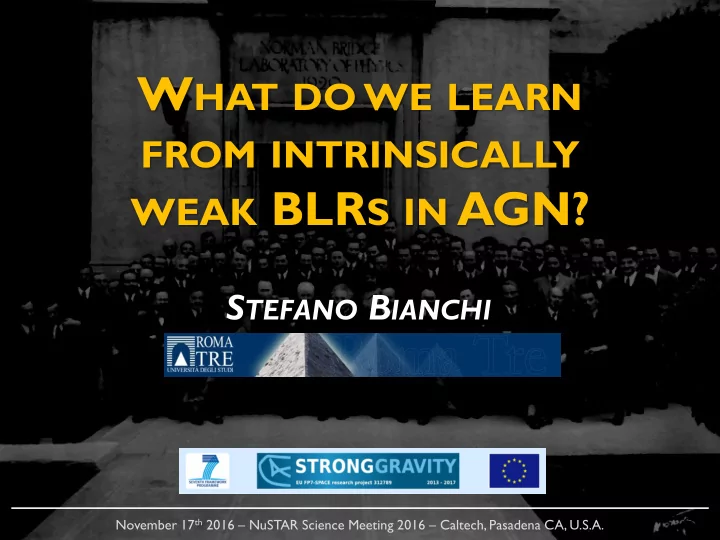

W HAT DO WE LEARN FROM INTRINSICALLY WEAK BLR S IN AGN? S TEFANO B IANCHI November 17 th 2016 – NuSTAR Science Meeting 2016 – Caltech, Pasadena CA, U.S.A.
T HE U NIFICATION M ODEL VIEW In standard Unified Models NLR (e.g. Antonucci 1993) type 1 and type 2 AGN have no intrinsic physical differences, their classification being instead determined by the BLR presence or absence of absorbing material along the line of sight to the object BLR T orus This scenario has been extremely successful, although some additional ingredients are needed in order to take into account all the observational evidence (e.g. Bianchi, Maiolino & Risaliti 2012)
Among the failed expectations of the Unification Model is the lack of broad optical lines in the polarized spectra of about half of the brightest Seyfert 2 galaxies, even when high-quality spectro- polarimetric data are available (e.g. Tran 2001, 2003) Ramos Almeida et al. 2016
NHBLR Sy2s may be associated with inefficient (low covering factor/column density) or obscured mirrors (Heisler et al. 1997) Heisler et al. 1997 A stronger dilution from the host galaxy or from a circumnuclear starburst can also make the detection of polarized broad lines harder (Alexander 2001, Gu et al. 2001)
A number of Sy2s without polarized broad lines may intrinsically lack a BLR Trump et al. 2011 If the BLR is part of a disk wind, it cannot form if its launching radius falls below a critical radius: the innermost orbit of a classic Shakura & Sunyaev (1973) disk (Nicastro 2000), or the transition radius to a radiatively inefficient accretion flow (Trump et al. 2011) No BLR is formed for Eddington rates lower than a critical value (~2 × 10 −3 𝑁 8 −1/8 )
Broad optical lines are generally absent in the spectra in polarized light of Seyfert 2s with low Eddington rates (Nicastro et al. 2003; Bian & Gu 2007;Wu et al. 2011) Marinucci et al. 2012 The threshold in Eddington rate is generally found at ~0.01 , both for optical/Xray surveys (Trump et al., 2011) and spectro- polarimetric data (Marinucci et al., 2012)
Below this threshold no broad lines are detected (either in total or polarized light), but above the threshold the BLR still cannot be detected in many Sy2s Marinucci et al. 2012 These sources should possess a BLR, something prevents us from observing it: more inclined sources (with respect to the line of sight) should intercept a larger column density of the torus and may obscure the medium responsible for the scattering of the BLR photons (Shu et al. 2007)
It appears that there are two Ichikawa et al. 2015 classes of NHBLR Sy2s: 1. low accretion rates, really lacking the BLR 2. higher accretion rate, likely hosting the BLR, but something prevents us from observing it
If the BLR cannot form in weakly accreting AGN, we expect the existence of “true” Seyfert 2 galaxies: optically T ype 2 objects, without obscuration These objects are found with simultaneous optical/X-ray observations, and have low Eddington rates: NGC 3147 ( 4 × 10 −5 − 3 × 10 −4 : Bianchi et al. 2008), Q2131427 ( 2 − 3 × 10 −3 : Panessa et al. 2009), and NGC 3660 ( 4 × 10 −3 − 2 × 10 −2 : Bianchi et al., 2012) Bianchi et al. 2012
They are not Compton-thick! NGC 3660 show clear evidence for intra-observation short-term variability Bianchi et al., 2012 NGC 3147 show long- term variability, and a NuSTAR broad-band spectrum with no signs of absorption/hard excess Bianchi et al., in prep.
Are true type Seyfert 2s rare objects? Few high SNR X-ray unobscured radio-quiet AGN (< 5%) lie below 𝑀 𝑐𝑝𝑚 /𝑀 𝐹𝑒𝑒 ≃ 0.01 (CAIXA: Bianchi et al. 2009) Low-accreting unabsorbed Sy2 candidates rise up to 30% in surveys (COSMOS: Trump et al. 2011) Similarly, ≃ 25% of low-accreting objects lack a hidden BLR in polarized light in obscured AGN (Marinucci et al. 2012) Trump et al. 2011
There are claims of highly accretingTrue Type Seyfert 2s: 1ES 1927 +654 (Gallo et al. 2013, but see alsoTran et al. 2011), GSN 069 (Miniutti et al. 2013), 2XMM J123103.2+110648 (Ho et al. 2012) The latter two sources have very uncommon soft spectra There are some LLAGN accreting at rates well below 0.01 with broad optical emission lines (e.g. M81; Ho, Filippenko & Sargent 1996) It seems that the formation of the BLR in objects with very inefficient accretion regimes may be different Elitzur & Ho 2009
We have recently found an object without X-ray obscuration and (simultaneously) a very weak broad (~2000 km/s) H α line (and no H β ): a True T ype 1.9 source !
It appears that BLR emission is intrinsically weak in this object ( 𝑀/𝑀 𝐹𝑒𝑒 ∼ 0.01 ), at odds with models explaining True Type 2s, where the BLR disappears moving towards large FWHMs Nicastro(2000)
S MALL COVERING FACTOR Is the BLR still forming or is it evaporating? The primary source has been active at least for the past 40 years S HIELDING OF THE IONIZING FLUX NLR Warped disk, self-shielding, wind? Both the NLR and the observer would view the primary source, while the BLR (if mostly equatorial) would see a much lower ionizing flux BLR Are these mechanisms viable interpretations also for True Type Sy2s? How many intermediate Seyferts are like Mrk0609? What is the link between Mrk609 and high-z, high-luminosity Weak Line Quasars (e.g. Shemmer et al. 2010)?
Recommend
More recommend